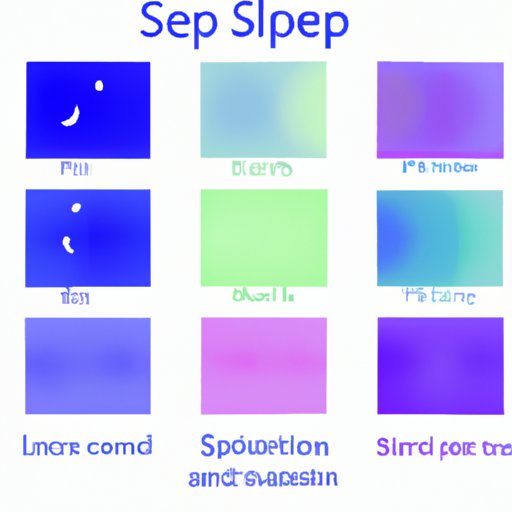
Introduction
Choosing the right color for your bedroom walls or bedding can make a big difference in how well you sleep at night. If you’re struggling to fall asleep or stay asleep, it might be time to consider changing up the colors in your sleep environment. In this article, we’ll explore the science behind how color affects sleep, identify the most sleep-inducing colors, and provide tips for incorporating them into your bedroom design.
The Science of Sleep: How Color Affects Your Circadian Rhythm
Your body’s natural sleep-wake cycle, also known as the circadian rhythm, is regulated by a variety of factors, including exposure to light. The release of melatonin, a hormone that helps to promote sleep, is triggered by darkness and inhibited by light. This is why it’s important to limit exposure to bright light, especially blue light, in the hours leading up to bedtime.
Colors can affect the release of melatonin in different ways. For example, red and orange hues are known to suppress melatonin production, making them less conducive to sleep. On the other hand, cool colors like blue and green have been shown to increase melatonin production, making them more sleep-inducing.
Can A Single Color Help You Fall Asleep Faster? Discover The Answer Here
The relationship between color and sleep is also influenced by our emotional response to different hues. Colors have been shown to affect our mood, with warm colors like red and yellow creating feelings of warmth and stimulation, while cool colors like blue and green promote calmness and relaxation.
Research has shown that blue is the most sleep-inducing color, followed closely by green. These colors have a calming effect on the nervous system, lowering heart rate and blood pressure, and reducing stress and anxiety levels. Other colors that are associated with sleep include lavender, which is known for its relaxing and soothing properties, and gray, which is neutral and calming.
Why Blue is the Ultimate Shade for a Good Night’s Rest
Blue is widely regarded as the ultimate sleep-inducing color. In fact, a study conducted by Travelodge found that people who slept in a blue bedroom got the most sleep, clocking an average of 7 hours and 52 minutes per night. This is attributed to the fact that blue is a calming color that can help to reduce stress and anxiety levels, making it easier to fall asleep and stay asleep.
Other research has also found that blue light has the greatest impact on melatonin production, making it more effective at promoting sleep than other colors. For these reasons, blue is the ideal color choice for your bedroom walls, bedding, and decor.
The Role of Color Psychology in Creating the Perfect Sleep-Inducing Bedroom
Color psychology is the study of how color affects human behavior and emotions. When it comes to sleep, color psychology can be used to create a bedroom environment that promotes relaxation, calmness, and tranquility.
To choose the right colors for a sleep-inducing bedroom, consider the following tips:
– Stick to cool colors like blue, green, and grey, which promote relaxation and calmness.
– Avoid warm colors like red and yellow, which create feelings of warmth and stimulation.
– Use neutral colors like beige or ivory to balance out bolder colors and create a soothing atmosphere.
– Incorporate soft, muted colors like lavender or pastel shades for a relaxing accent.
– Opt for matte or satin finishes rather than high-gloss or shiny surfaces, which can reflect light and create visual stimulation.
Sleep Better Tonight: The Colors You Need to Add (or Avoid) in Your Bedroom Decor
Now that you know which colors to look for when creating a sleep-friendly bedroom environment, it’s time to start incorporating them into your decor. Here are some tips for getting started:
– Choose a blue or green paint color for your walls to create a calming backdrop for your bedroom.
– Add accents in soothing shades of lavender or grey for a subtle pop of color.
– Invest in high-quality bedding in calming shades of blue or green to promote relaxation.
– Avoid bold patterns or loud colors that can create visual stimulation and interfere with sleep.
– Use soft lighting rather than bright or harsh overhead lighting, which can inhibit melatonin production.
Conclusion
Getting a good night’s sleep is essential for your physical and mental well-being. By understanding the science and psychology of color, you can create a bedroom environment that promotes relaxation, calmness, and tranquility, making it easier to fall asleep and stay asleep. Incorporate these tips into your bedroom design for a better night’s sleep tonight.




